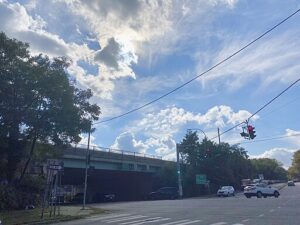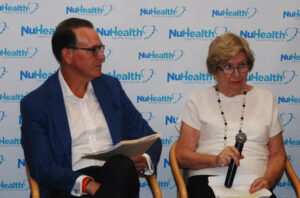By Lara Rydesky
Editor’s note: The following is part two of an investigative series examining the state of Long Island’s water supply.
In 2023, four Long Island water suppliers received exemptions for 1,4-dioxane contamination levels that exceeded the state maximum. This came after deferrals were granted to more than 20 water districts after the New York State Department of health set an official maximum contaminant level (MCL) for 1,4-dioxane in August 2020.
The MCL, one microgram per liter, was intentionally set much lower than what the federal Environmental Protection Agency deems dangerous for daily consumption. While many water suppliers have exceeded New York’s MCL, none have come near the EPA’s recommended limit. Regardless, Long Islanders might still be concerned about multiple years of exposure to this potential carcinogen, which has been linked to liver cancer in animals.


“It’s really a chronic, accumulative kind of concern, especially at the very low levels where we set our standard,” said Gary Ginsberg, director of the state health department’s Center for Environmental Health. “In this case, there’s no human evidence, so these are all animal studies, and we set the standard far below where any animal testing has shown there to be an actual health effect.”
What the water-quality reports say
Long Island water suppliers are required to release annual water quality reports detailing, among other items, the tested levels of potentially harmful contaminants found in water that year. These numbers appear alongside a “Yes” or “No” to show if the tested level is considered a violation by the NYSDOH.
In 2022, the Village of Hempstead was not issued a violation, despite its 1,4-dioxane levels being
detected at a maximum over 10 times the MCL.
This is because, in January 2021, the village was granted a deferral for 1,4-dioxane contamination, meaning that a violation (and its consequences) would not be issued on the condition that “the water system agrees to schedule for corrective action and compliance with the new 1-4-Dioxane MCL,” according to the report.
Hempstead Village was not alone, it being one of 21 Long Island suppliers to initially receive a two-year deferral, as reported by Newsday. Of those, 17 were approved for one-year extensions that expired last August.
Since then, four water suppliers, the Town of Hempstead, Village of Hempstead, Jericho Water District and Liberty Utilities Corporation’s Merrick District applied for and received an additional year exemption to install needed equipment to reduce their 1,4-dioxane levels.
“Our job is to make sure that they are testing, and if they are in exceedance of the MCL that they come in with a plan to make an engineering plan to build one of these AOP plants […] so that this is removed from the water as quickly as possible,” said Ginsberg.
It is worth noting that these deferrals were specific to the implementation of new MCLs for perfluorooctanoic acid (PFOA), perfluorooctane sulfonic acid (PFOS) and 1,4-dioxane in August 2020, and do not apply to violations of any other contaminants.
Upon the MCL’s first implementation in 2020, New York water suppliers were required to reach compliance by a DOH regulated timeline. If a water system was unable to meet these deadlines because of exceedingly complex or time-consuming circumstances, they were granted a deferral.
Jericho Water District and Liberty Utilities have both cited supply chain issues for their interrupted progress building facilities for the advanced oxidation process (AOP) required to rid 1,4-dioxane from groundwater.
“Typically our treatment is something called granulated activated carbon, so that can remove pesticides, herbicides, pharmaceuticals, chlorinated compounds, pretty much everything but 1,4-dioxane,” said Thomas Schneider, director of water quality and laboratory services for the Suffolk County Water Authority (SCWA). “The challenge with 1,4-dioxane is it’s such a tough molecule to remove, it has to go through an advanced oxidation procedure. So, it actually has to break down in this reactor, and then we filter it out with the carbon.”
The SWCA was granted a deferral in February 2021, then again in September 2022. At the MCL’s introduction, 11 of SWCA’s distribution areas measured levels above the MCL. As of August 2023, the deferral’s expiration date, this was reduced to only three of its distribution areas.
“This is probably one of the largest challenges that the Water Authority has ever undertaken, to comply with these treatment systems in a very expedited fashion,” said Joseph Pokorny, SCWA’s deputy CEO for operations. “And we’re not done, we’re still building.”
“This is probably one of the largest challenges that the Water Authority has ever undertaken, to comply with these treatment systems in a very expedited fashion, And we’re not done, we’re still building.”
Joseph Pokorny, SCWA deputy CEO for operations
What’s being asked of residents?

Each year, Long Island residents pay hundreds of dollars for their water, often not considering whether that water is potentially harmful to drink.
“I was born on Long Island,” said Hofstra University sophomore Elvina Tso. “I’ve been living here all this time and I’ve never heard of it being an issue.”
As the 1,4-dioxane levels continue to be monitored and treated over the years, residents might see their water bills rise to pay for the new water treatments and facilities.
“The Village of Hempstead, for example, raised its rates in August and expects to raise them again next summer. Villagers whose water places them in the highest rate block pay $9.95 per thousand gallons,” reported Newsday last November.
Some of these costs are covered by grants state grants.
“In an effort to reduce the costs for our customers, we’ve been pretty aggressive in seeking grant funding from New York State,” said Daniel Dubois, director of external affairs at SCWA. “The state has a pot of money that they put out every year. They ask for applications, and we’ve been pretty successful. We’ve been awarded $34 million in grant funding from the state.”
Still, 1,4-dioxane levels in Jericho and Hempstead continue to rise, despite their suppliers’ efforts.
In the meantime, residents supplied by these districts and those surrounding are urged to conserve water. Some water districts have closed contaminated wells, reducing the amount of water available for use. Even suppliers that do not exceed the MCL for 1,4-dioxane, like the Village of Sands Point Water Department, maintain emergency interconnections with other suppliers that do exceed the MCL, in this case the Port Washington Water District.
“From time to time in past years, usually during summer drought conditions or tank rehabilitation projects, our department has received water from PWWD,” stated the Village of Sands Point Water Department on its 2020 water quality report. “Our department will notify residents should it be necessary to utilize the interconnection this year.”
As supply-chain issues persist, Long Islanders should keep an eye on their water districts’ 1,4-dioxane levels. Annual water-quality reports for Long Island suppliers are publicly available online.
“It’s a chronic concern, not day to day, week to week, or even month to month concern,” said Ginsberg. “It’s more that we’re trying to prevent exposure in the long term.”









